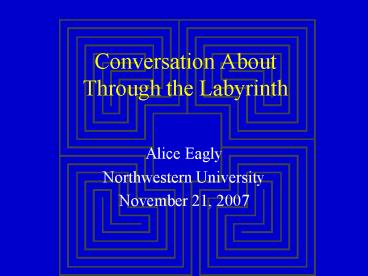Conversation About Through the Labyrinth - PowerPoint PPT Presentation
1 / 25
Title:
Conversation About Through the Labyrinth
Description:
To address the roots of gender inequality. Social disadvantage of women is concentrated lack of ... Davison & Burke (2000) Review of 49 Resume Experiments ... – PowerPoint PPT presentation
Number of Views:37
Avg rating:3.0/5.0
Title: Conversation About Through the Labyrinth
1
Conversation AboutThrough the Labyrinth
- Alice Eagly
- Northwestern University
- November 21, 2007
2
Why Study Leadership?
- To address the roots of gender inequality
- Social disadvantage of women is concentrated lack
of access to power authority - Women not generally devalued but regarded as
deficient in qualities needed to exercise power
over others - To produce gender equality, power would have to
be equally shared That means leadership equally
shared.
3
What Needs to Be Explained?
- Why have women now gained more access to powerful
leadership positions? - Why do men continue to have far more access than
women do?
4
Evidence-Based Answers What Researchers Can
Provide
- Why evidence-based answers to questions in this
area are better than other, more intuitive
answers - How make answers interesting compelling enough
to the public?
5
(No Transcript)
6
(No Transcript)
7
Eagly Carli Approach
- Provide an overarching metaphor that frames
complexity - Labyrinth as metaphor for varied challenges that
women encounter as they progress toward
leadership roles
8
Goals
- Provide conceptual analysis in lucid, jargon-free
prose - Establish credibility with excellent research
- Ask questions give answers
- Spell out implications
- For organizations
- For individuals
- Use varied concrete examples for
illustrationlittle stories
9
Questions
- Is there still a glass ceiling?
- Where are the women leaders?
- Are men natural leaders?
- Do family responsibilities hold women back?
- Is discrimination still a problem?
- What is the psychology of prejudice toward female
leaders? - Do people resist womens leadership?
- Do women lead differently from men?
- Do organizations compromise womens leadership?
- How do some women find their way through the
labyrinth? - How good are women leaders and what does their
future hold?
10
Is Discrimination Still a Problem?
- Studies of wages, hiring, and promotion (by
economists sociologists) unexplained gender
gaps suggest YES. - Controlled experiments (by psychologists
management researchers) - For example, resume experiments varying sex of
job applicant
11
Davison Burke (2000) Review of 49 Resume
Experiments
12
Psychology of Prejudice Against Women As Leaders
- Construal of women as communal
- nice, friendly, socially skilled, egalitarian
- Construal of men as agentic
- dominant, assertive, tough-minded, take charge
13
Gender Stereotypes Koenig Eagly, 2007
- Communion
- Warm, nurturing, sincere, kind
- Competence
- Intelligent, competent
- Agency
- Competitive, aggressive, dominant
14
Stereotypes of Women MenKoenig Eagly, 2007
15
Role Incongruity Problem for Women as Leaders
- Construal of leaders mainly agentic
- self-confident, assertive, take charge, solve
problems, inspire others - especially in masculine settings at higher
levels - More like men than women
- Role incongruity can produce prejudice against
female leaders
16
Evidence of Role Incongruity for Female Leaders
- Think managerthink male paradigm of Virginia
Schein - Participants rated a manager/leader role, men, or
women on traits that differentiate between men
and women - Compare
- Similarity of men and managers
- Similarity of women and managers
- Replicated many times, across time and in
different countries, with different participant
groups - Review in progress
17
Think-ManagerThink Male
Based on 50 studies
18
Produces the Double Bind ProblemFor Female
Leaders
- Influence from leadership role
- Encourages masculine style (just do the job in
the typical way) - Discourages feminine style (not tough enough,
too nice, doesnt take charge) - Influence from female gender role
- Encourages feminine style (be nice, kind,
forgiving) - Discourages masculine style (just like a man,
battle axe, iron lady) - Female leaders are buffeted by cross-pressures
- Encounter negative sanctions for being too
masculine or too feminine
19
How Do Women Leaders Resolve these
Cross-Pressures?
- Women often split the difference with behavior
that is similar to male colleagues, but somewhat
different in a culturally feminine direction - Evidence? Examine leadership styles of men and
womensmall overall differences - Women more participative democratic
- Women more transformational and effective at
using positive incentives - Behaviors correspond to good managerial
practices
20
Brings the Female Advantage Theme
- After years of analyzing what makes leaders most
effective and figuring out who's got the Right
Stuff, management gurus now know how to boost the
odds of getting a great executive Hire a
female.
- Business Week
- November 20, 2000
- By Sharpe
- As Leaders, Women Rule
21
What Happened to Female Disadvantage? The
prejudice
- It is still there but in diminished form in most
contexts
22
Consider Gender-Based Reservations about Hillary
Clinton
- When the crunch comes, the toughest issue for
Clinton may be the one that so far as been talked
about least. If she runs, shell be handicapped
by her gender. Anyone who thinks it wont be
difficult for a woman to get elected president of
the United States should go home, take a nap,
wake up refreshed and think again.
- New York Times
- May 19, 2006
- By Herbert
23
Ambivalence Reigns Toward Women as Leaders but
Prejudice Has Lessened
- Changes over time
- Think managerthink male
- Women now perceived as more like managers than in
earlier data - Public opinion data
24
Prefer Man or Woman As Boss(U. S. Gallup Poll)
25
Evidence-Based Recommendations
- For organizations
- See Harvard Business Review article
- For individual women
- Blend agency communion
- Have to quell doubts that are not agentic enough
that are not communal enough - Build social capital
- On work-family issues, keep in mind the long-term
advantages in well being and health that come
from having it all












![⚡Read✔[PDF] Tim Walker: Wonderful Things PowerPoint PPT Presentation](https://s3.amazonaws.com/images.powershow.com/10072932.th0.jpg?_=20240704114)


















